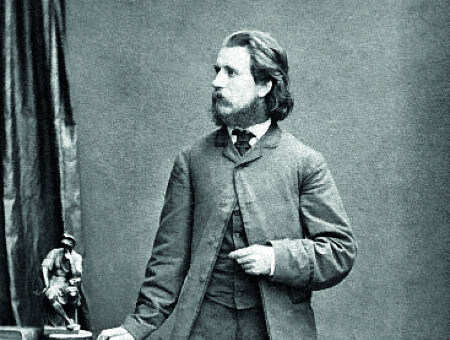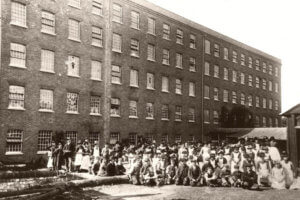Tring’s Poet

From humble beginnings, working in the town’s Silk Mill as a boy, Gerald Massey became a respected poet and author.
Massey House in Brook Street remembers one of the town’s sons who became a respected Victorian poet and author despite a poor start in life.
The apartment building is named after Gerald Massey – known as Tring’s Poet – the son of an illiterate canal boatman, who became a respected poet and writer on spiritualism and Ancient Egypt, mixing with literary giants such as Lord Alfred Tennyson and Robert Browning.
 Born Thomas Gerald Massey in a flint-stone hut in Gamnel Wharf in Tring in 1828, he worked at the Silk Mill from the age of seven, until the factory suffered a serious fire. He worked from six in the morning until half-past six in the evening for ninepence per week. In an interview with The Bookman in 1897 he recalled that he was an ‘inveterate gambler’, and on the Saturday lost all his first week’s wages at pitch-and-toss!
Born Thomas Gerald Massey in a flint-stone hut in Gamnel Wharf in Tring in 1828, he worked at the Silk Mill from the age of seven, until the factory suffered a serious fire. He worked from six in the morning until half-past six in the evening for ninepence per week. In an interview with The Bookman in 1897 he recalled that he was an ‘inveterate gambler’, and on the Saturday lost all his first week’s wages at pitch-and-toss!
He wrote: ‘Having had to earn my own dear bread by the eternal cheapening of flesh and blood thus early, I never knew what childhood meant. I had no childhood.’
However, he credited his drive to his mother ‘a fiery-spirited, great-hearted little woman’.
Massey learned to read at a penny school. He would have access to books that had been left at his family home, such as the Bible and the writing of John Bunyan, moving on to Robinson Crusoe and a few Wesleyan tracts.
At 14 he was packed off to London, and his first writing appeared in the Aylesbury News in 1843. Not long after that he issued a shilling pamphlet of poems – Poems and Chansons, by a Tring Peasant Boy.
He joined the Chartist agitation in 1848 and a year later started the The Uxbridge Spirit of Freedom, which printed 11 issues and was written by workingmen. It got him into trouble – he was fired from several publishing jobs for producing it, but remained committed to the cause of the working man. In 1850 he published Voices of Freedom and Lyrics of Love.
It was in 1854 that he published what he considered his first proper volume – The Ballad of Babe Christabel, and Other Poems. It received rave reviews in the press and five editions were sold in one year. Among those whose attention he attracted was the novelist George Eliot, who used him as her model for Felix Holt in her book, The Radical.
The life of a writer did not bring him great wealth – and in 1865, Lord Brownlow settled Massey’s debts and the family were offered an estate cottage in Little Gaddesden. However, the villagers were suspicious of his wife Rosina, a well-known spiritualist medium, and her clairvoyant abilities, believing her to be a witch. The Brownlows then offered the family Ward’s Hurst, a large isolated farmhouse, where they lived rent-free until they moved to London in 1877.
He later moved to Edinburgh where he edited the Edinburgh Evening News, and wrote for the North British Quarterly Review, and for the Witness. He reviewed poetry for the Athenæum, for the next 10 years.
He left Scotland in 1858 and joined the lecture circuit, where he remained in great demand for the next 10 years or so.
In 1869 he published The Haunted Hurst, A Tale of Eternity, which he said was based on a personal experience in a house that was haunted. He said the publication ‘did for me in a literary way. A well-known editor spoke of me as having deserted Liberalism and gone over to “those spiritualists”.’
In 1872 he published a little volume, Concerning Spiritualism, which prompted Lord Tennyson to write to him saying, ‘I have read your book more than once, and have bought copies of it to give to friends.’ Massey also used to meet Robert Browning at Ashridge when he visited Lady Marian Alford. He wrote about him in the Quarterly and reviewed his poetry in the Athenæum.
Massey’s specialisms were varied – he published a series of study of Shakespeare’s sonnets, and in his later years he began a long research into religious origins, and the mythology of Egypt, producing The Book of the Beginnings, The Natural Genesis and Ancient Egypt: The Light of the World, published between 1881 and 1907.
Massey died at his home in South Norwood Hill, London, in 1907, and was buried in the family tomb in Southgate Cemetery.
With thanks to Tring & District Local History Society
